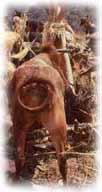|

Festivals

Festivals form an essential aspect of the socio-cultural
life of the people of the state. As a matter of fact, festivals are the mirror of the
people's culture. Since agriculture is the mainstay of the population, naturally the
festivals celebrated by the people are closely connected with their occupation. Such
festivals are celebrated at a larger scale for thanking the gods for their providence and
for saying a prayer for a bumper crop. Throughout the year festivals are celebrated by one
or the other tribe. Some of the important festivals are Solung, Mopin, Losar, Boori Boot,
Dree, Nechi Dau, Khan, Kshyatsowai, Loku, Longte Yullo, Moi, Nyokum, Ojiale, Reh, Sanken,
Si-Donyi and Tamladu.
Animal sacrifices are a common
ritual in most of the festivals, particularly in the Non-Bodic tribes. The festivals have
been firmly blended with the lifestyle of the people of Arunachal Pradesh. For some
communities like the Mijis these are the occasions to bring all people together who might
otherwise be scattered in far flung villages. This serves as a reminder of the richness of
their cultural heritage.
The spring time festivals are celebrated during the period from January
to April by the different groups. In the celebrations of these festivals, the religious
rites and the sacrifices are generally performed by their priests assisted by some select
male members.
The Losar Festival :
The losar festival of the Monpas, which is their new year,
is celebrated for five days. On the eve of the festival people clean out their homes to
usher in the new year and discard the old. The dirt and grit of the old year is considered
to symbolize ill health. During the five days of festivities prayers are offered for
prosperity and good health, the festivities include the hoisting of religious flags atop
their homes; visits to the homes of friends and relatives; holy Buddhist scriptures are
read in every home and butter lamps are lit in houses and the campuses.
The Reh Festival :
Appeasement of the deities who control the peace and
prosperity of the people is through behind the six day celebrations of the Reh festival,
essentially associated with the Idu Mishmis. The festival comes to an end with great
fanfare and the priest dance performed during the six days is its special attraction.
Top

The Ojiyale Festival :
The wanchos celebrate their most popular festival, Ojiyale
during March - April, for a period of six to 12 days interspersed with prayer, songs and
dance. Villagers exchange bamboo tubes of rice beer as a mark of greeting and goodwill.
Pigs' skin is offered to the village chief as a mark of respect.
The Tamladu Festival :
Another important festival is
Tamladu, essentially
celebrated by the Digaru Mishis tribe. During the festival, prayers are offered to the god
of the earth and the god of the waters for protection against natural calamities. The
supreme - Lord Jebmalu, is worshipped for the prosperity and welfare of human being, the
standing crops and domestic animals.
The Khan Festival :
Another is the Khan festival, an occasion for the reunion
of the people. Besides the usual festivities, the significance of the festival lies in the
ceremony whereby the priest ties a piece of wool around everybody's neck. The belief is
that the enchanted thread will bring good luck to each of them.
Top

The Sanken Festival :
It is an occasion to bathe the images of Lord Buddha
ceremoniously. This also heralds the new year and people sprinkle water on each other a
sign of merriment.
The Mopin Festival :
One of the groups celebrate Mopin for wealth and prosperity
as also good health and universal happiness. Smearing of rice powder on each others faces
marks the beginning of the festival which is celebrated for five days.
The Mol Festival :
The Mol festival of the Tangsas is celebrated for three
days to welcome the new year.
Top
|



